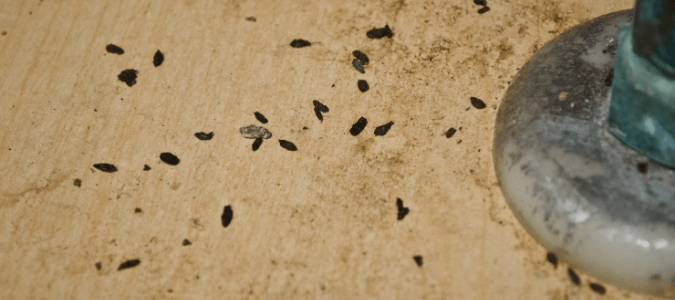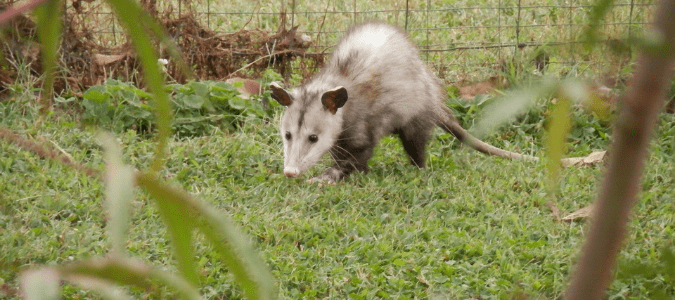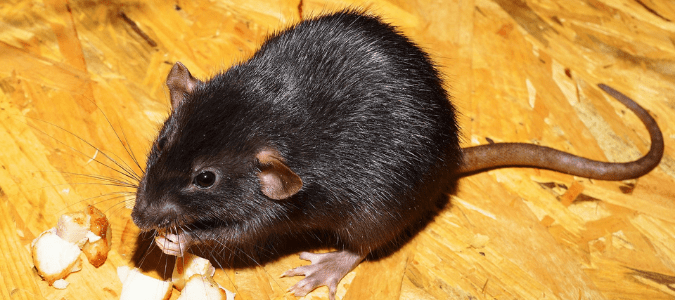What does rat poop look like? This is a question that pest control specialists answer a lot. Unfortunately, it’s common to find something in your home or garage that looks like rat poop. Rats are hardy animals with lots of tricks for getting into people’s homes, attics and garages. When you find what looks like rat poop, you might wonder what type of rat it came from. Is it from a Norwegian rat or a roof rat? Could it actually be from some other pest, like a mouse?
Finding rat poop on your property can indicate a nearby infestation, so it’s important to know how to identify it. Fortunately, there are several characteristics that can tell you if what you’ve found is likely to be rat poop or something else. That way, you’ll know when it’s time to call in a pest control professional.
The two main types of rats that commonly infest people’s homes or garages are roof rats and Norwegian rats. Both can cause property damage and transmit illnesses to humans, so any type of rat infestation should be addressed as soon as possible by a licensed pest control specialist.
Identifying Roof Rats and Roof Rat Poop
Roof rats are also sometimes called black rats or ship rats, but they’re most often called roof rats. They got this name because they usually seek out shelter in higher-up parts of buildings, like the attic or the roof’s eaves.
Roof rats are usually about six to eight inches long, with scaly tails even longer than their bodies. Their fur is dark brownish-black. Fresh roof rat droppings are skinny, dark-brown pellets with pinched ends. As their droppings age and dry out, their color may turn to gray or even whitish.
Rat poop as a rule is bigger than mouse poop, since rats themselves are bigger than mice. Mouse poop is about the size and shape of a grain of rice. If this matches the description of the poop you’ve found on your property, you might have mice living nearby instead of rats. But if the poop is about twice as long and wide as grains of rice, you may have found roof rat poop.
Identifying Norwegian Rats and Norwegian Rat Poop
Norwegian rats are also called Norway rats or, even more commonly, sewer rats. Norwegian rats are usually a lighter brown color than roof rats, with slightly smaller ears and shorter tails but larger bodies. Since these rats are a little bigger than roof rats, their poop is bigger too. It’s the same basic shape and color as roof rat droppings, but Norwegian rat poop is usually more rounded on the ends. Like roof rat poop, Norwegian rat poop turns gray over time, since it dries out as it gets old.
Like other rats, both roof rats and Norwegian rats have long front teeth that need to be filed down regularly. Rats have to gnaw every day, which is a big part of the extensive property damage that a rat infestation can cause. Rats will chew through wooden beams, baseboards, drywall, PVC pipes and even electrical wiring. They can cause damage that is expensive to fix, as well as damage that can actually be a safety hazard. Fires have started in homes as a result of rats gnawing the protective coating off electrical wires.
Beyond the problem of property damage, rat poop and urine can carry bacteria and transmit illnesses to humans. This is why it’s so important to look out for rat poop and other signs of a rodent infestation on your property. You might find rat droppings in the corners of your garage, in crawl spaces or the insulation within walls, on shelving, or on the tops of cabinets.
If you find gnaw marks on your cabinets, drywall, baseboards or elsewhere, this is another sign of rat activity. Shredded paper and other nesting materials can be another sign. Greasy rub marks along baseboards or the tops of rafters can also be a sign of a rodent infestation. These animals usually follow the same paths from their nests to their food and water sources, and the natural oils in their fur rub off onto the walls as they run along.
Contacting a professional for rodent control can save you lots of time and aggravation. Unfortunately, getting rid of rats on your own is notoriously difficult. These pests are prolific breeders. While there may be just five or 10 rats in a nest, there are often several nests near each other in what is known as a colony. And there can be up to 100 rats in a single colony!
Most people who try to resolve their own rat issue wind up inadvertently making the problem worse. They eventually call in professional help when it becomes clear they aren’t making any headway. Reaching out to a pest control professional will ensure that the rodent problem has been handled. A pro can also re-inspect your property periodically to make sure the problem doesn’t return.
Possum Versus Rat: How to Tell the Difference
So you’ve found what looks like rodent poop, or maybe you’ve spotted an animal and you aren’t sure if it’s a possum or a rat. How can you tell the difference? Possums and rats are both furry animals with rounded ears, beady black eyes and long tails. There are some important differences between possums and rats, however, that can help you tell these animals—and their poop—apart.
The first major difference between possums and rats is the fact that rats are rodents, but possums aren’t. Possums, as you can see in the image above, look a bit like rats, but they are actually marsupials. This means they have a pouch on their lower abdomens that they use to carry their young before the babies are fully developed. Possums also carry their young on their backs, which rats don’t do. If you ever spot what looks like a big, furry rat carrying its babies around, it’s almost certainly a possum, not a rat.
Appearance
The biggest difference between possums and rats that most people would notice is their appearance. Full-grown possums are quite a bit bigger than rats, and their fur is whitish-gray instead of darker gray, brown or black, like rat fur. Their fur is also longer and fluffier than rat fur. Possums’ ears are usually darker than their fur, and sometimes their feet are as well. Their faces are also flatter than rats’ faces, with their eyes closer together at the front.
Rats’ ears and legs are usually the same color as the rest of their fur. Their faces are narrower and pointier than possums’ faces, with their eyes positioned more on each side of their face. Their bodies and tails are different from possums’ bodies and tails, and may be proportionately longer and skinnier.
Still, sometimes it can be hard to tell a baby possum apart from an adult rat, since they are similar sizes. Fortunately, there are also several differences between these two animals’ behavior patterns that are clues to their identity.
Behavior
For example, rats often invade people’s homes or garages in search of shelter and food. Possums, on the other hand, rarely get into people’s homes. They are naturally fearful of humans and typically keep their distance. They are also mostly nocturnal, while rats can be active both at night and during the day.
Rats have constantly growing front teeth, which is why they gnaw. Since possums aren’t rodents, they don’t have that type of teeth and don’t need to gnaw. For this reason, and since they don’t usually infest people’s homes or garages, they aren’t associated with destroying people’s property the way rats do. However, on occasion, possums are known to dig up lawns at night to look for food.
Possums also don’t carry diseases that can make people sick the way rats do. Even rabies is extremely rare in possums. For all of these reasons, possums don’t pose much of a threat to people or their property. Rats, on the other hand, can cause lots of problems for people. They can damage our homes, make us sick and more.
If you believe you may have a rat problem, it’s a good idea to contact a pest management specialist. These professionals will thoroughly inspect your property to determine whether you are dealing with rats or some other pest. They can determine the right rodent or wildlife control plan that is tailored to your particular home and needs. They can also conduct follow-up inspections to make sure the problem doesn’t return.
How Long Can a Rat Live Without Food?
How long can a rat live without food? This is an important question to ask when you’re trying to keep rats away from your property. Rats have varied diets. They can live happily on the food in your pantry or on your countertops, or the fruit that falls from the trees in your yard. That’s why cutting off their food supply is an important part of pest control.
Like most mammals, rats can’t live without food for long. If you have rats living on your property, cutting off their food supply will go a long way toward getting rid of the rats themselves. If they don’t have a reliable food source, rats will move along to someplace where food is more available.
To cut rats off from their food in and around your home, focus on keeping all foods in airtight containers that rats can’t get into. This includes pet food as well as the food in your pantry and kitchen. If you have fruit- or nut-bearing trees in your yard, clearing away fallen fruits and nuts will also help keep rat populations low outdoors. And fewer rats in your yard means fewer rats seeking shelter inside your home or garage.
It’s very smart to limit rats’ access to food and water sources, but this measure works best in tandem with a professional pest treatment plan. A pest control professional can give you advice on other steps you can take on your own to keep rats away from your home. Any steps you take can support the comprehensive rodent control plan designed by your pest management specialist.
ABC Can Control the Rodents and Wildlife on Your Property
When you’re dealing with a rodent or wildlife problem, it can feel like it’s consuming your life. Instead of handling this problem on your own, contact ABC Home & Commercial Services. Our professionals will develop an effective pest control plan, so you don’t have to worry about these critters anymore.



